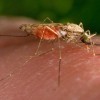Abstract
Anopheles gambiae Giles is commonly called the African malaria mosquito because it is the most efficient vector of human malaria in the Afrotropical Region. They are considered to be one of the world’s most important human malaria vectors because of their susceptibility to the Plasmodium parasite, their preference for humans as a host, and their indoor-feeding behavior. Due to their short development time and their preference for developmental habitats near human dwellings, Anopheles gambiae are considered effective vectors of human malaria, as well as lymphatic filariasis (elephantiasis). This 6-page fact sheet was written by Sabrina A. White and Phillip E. Kaufman, and published by the UF Department of Entomology and Nematology, September 2014.
References
Apperson CS, Lanzaro GC. 1991. Comparison of host feeding patterns between Anopheles quadrimaculatus sibling species A and B. Journal of the American Mosquito Control Association 7: 507-508.
Carpenter SJ, LaCasse WJ. 1955. Mosquitoes of North America (North of Mexico). Berkeley: University of California Press. https://doi.org/10.1525/9780520325098
Carpenter SJ, Middlekauff WW, Chamberlain RW. 1946. The Mosquitoes of the Southern United States East of Oklahoma and Texas. The American Midland Naturalist Monograph Series No. 3. University Press. Norte Dame. 292 pp.
CDC. (2004). Anopheles mosquitoes. Malaria. http://www.cdc.gov/Malaria/biology/mosquito/index.htm (11 September 2007).
CDC. (2005). CDC Entomology Branch-Overview of Current Activities. West Nile Virus. (11 September 2007).
Connelly R. (2007). Mosquito Information website. http://mosquito.ifas.ufl.edu/ (12 September 2007).
Efird PK, Inman AD, Weathersbee AA, Meisch MV. 1992. Efficacy of various ground-applied pyrethroids against adult Anopheles quadrimaculatus in the rice growing region of Arkansas. Journal of the American Mosquito Control Association 8: 77-79.
Fasulo TR. (2002). Mosquitoes 1 and Mosquitoes 2. Bug Tutorials. University of Florida/IFAS. CD-ROM. SW 160.
Jensen T, Kaiser PE, Barnard DR. 1994. Adaptation to intermittently flooded swamps by Anopheles quadrimaculatus species C1 (Diptera: Culicidae). Environmental Entomology 23: 1150-1154. https://doi.org/10.1093/ee/23.5.1150
Jensen T, Cockburn AF, Kaiser PE, Barnard DR. 1996. Human blood-feeding rates among sympatric sibling species of Anopheles quadrimaculatus mosquitoes in northern Florida. American Journal of Tropical Medicine and Hygiene 54: 523-525. https://doi.org/10.4269/ajtmh.1996.54.523
Kramer VL, Gargia G, Colwell AE. 1987. An evaluation of the mosquitofish, Gambusia affinis, and the inland silverside, Menidia beryllina, as mosquito control agents in California wild rice fields. Journal of the American Mosquito Control Association 3: 626-632.
Lacey LA, Inman A. 1985. Efficacy of granular formulations of Bacillus thuringiensis (H-14) for the control of Anopheles larvae in rice fields. Journal of the American Mosquito Control Association 1: 38-42.
Magnarelli LA. 1975. Life history and physiological age studies of Anopheles quadrimaculatus Say in central New York State. Proceedings of the New Jersey Mosquito Control Association 83-89.
McLaughlin RE, Vidrine MF, Willis OR. 1987. Distribution of Anopheles quadrimaculatus and An. crucians larvae within rice field habitats in Southwestern Louisiana. Journal of the American Mosquito Control Association 3: 574-578.
Moncayo AC, Edman JD, Turell MJ. 2000. Effect of eastern equine encephalomyelitis virus on the survival of Aedes albopictus, Anopheles quadrimaculatus, and Coquillettidia perturbans (Diptera: Culicidae). Journal of Medical Entomology 37: 701-706 https://doi.org/10.1603/0022-2585-37.5.701
Nayar JK, Sauerman Jr DM. 1975. Physiological basis of host susceptibility of Florida mosquitoes to Dirofilaria immitis. Journal of Insect Physiology 21: 1965-1975. https://doi.org/10.1016/0022-1910(75)90229-2
O'Malley CM. 1992. The biology of Anopheles quadrimcaulatus Say. Proceedings of the New Jersey Mosquito Control Association 79: 136-144.
Reinert JF, Kaiser PE, Seawright JA. 1997. Analysis of the Anopheles (Anopheles) quadrimaculatus complex of sibling species (Diptera: Culicidae) using morphological, cytological, molecular, genetic, biochemical, and ecological techniques in an integrated approach. Journal of the American Mosquito Control Association 13 (Supplement) 1-102.
Robert LL, Santos-Ciminera PD, Andre RG, Schultz GW, Lawyer PG, Nigro J, Masuoka P, Wirtz RA, Neely J, Gaines D, Cannon CE, Pettit D, Garvey CW, Goodfriend D, Roberts DR. 2005. Plasmodium-infected Anopheles mosquitoes collected in Virginia and Maryland following local transmission of Plasmodium vivax malaria in Loudoun County, Virginia. Journal of the American Mosquito Control Association 21: 187-193. https://doi.org/10.2987/8756-971X(2005)21[187:PAMCIV]2.0.CO;2
Robertson LC, Prior S, Apperson CS, Irby WS. 1993. Bionomics of Anopheles quadrimaculatus and Culex erraticus (Diptera: Culicidae) in the Falls Lake Basin, North Carolina: seasonal changes in abundance and gonotrophic status, and host-feeding patterns. Journal of Medical Entomology 30: 689-698. https://doi.org/10.1093/jmedent/30.4.689
Rutledge RC, Baker RH, Morris CD, Nayar JK. (2005). Human malaria. EDIS. http://edis.ifas.ufl.edu/MG103 (12 September 2007).
Weathersbee III AA, Meisch MV. 1988. An economical lightweight portable resting unit for sampling adult Anopheles quadrimaculatus populations. Journal of the American Mosquito Control Association 4: 89-90.
Weidhass DE, Woodard DB, Schmidt CH, Ford HR. 1965. Biology of Anopheles quadrimaculatus under field conditions in central Florida. Annals of the Entomological Society of America 58: 145-150. https://doi.org/10.1093/aesa/58.2.145

